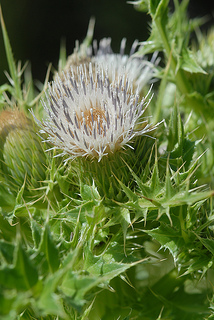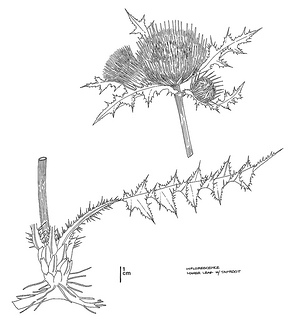(Cirsium scariosum var. loncholepis)
 Cirsium scariosum var. loncholepis . Photo © Chris Winchell.
Cirsium scariosum var. loncholepis . Photo © Chris Winchell.
 Cirsium scariosum var.loncholepis. CDFW illustration by Mary Ann Showers. (Click to enlarge)
Cirsium scariosum var.loncholepis. CDFW illustration by Mary Ann Showers. (Click to enlarge)
La Graciosa thistle is listed as threatened by the state of California, which means that killing or possessing the plant is prohibited by the California Endangered Species Act (CESA). La Graciosa thistle is also listed as endangered under the federal Endangered Species Act. La Graciosa thistle is a short-lived perennial plant in the sunflower family with spiny leaves and flower heads. Its compact flower heads have long, white corollas with pink to purple tubes and purple anthers.
La Graciosa thistle has only been found on the coast of southern San Luis Obispo and northern Santa Barbara counties, and grows in riparian habitat, often around seeps or in marshes. La Graciosa thistle has probably always had a limited range, but it has declined significantly in population numbers and number of occurrences in the past twenty years. According to the 5 year review completed by the U.S. Fish and Wildlife Service in 2011, there are only 8 extant occurrences of La Graciosa thistle among 4 populations at Callender Dune Lakes, Oso Flaco, Guadalupe Dunes, and the Santa Maria River.
The habitat that La Graciosa thistle occurs in has disappeared and degraded due to development and urbanization, which is the main threat to the persistence of La Graciosa thistle. Development and urbanization causes direct habitat loss and fragmentation, and degradation due to erosion, sedimentation, nutrient loading, and invasion of non-native species. Biostimulation, a process in which nutrients are added to the environment to accelerate the growth of certain bacteria, also threatens La Graciosa thistle habitat. Other activities such as oil extraction, ground water diversion, and grazing are also threats. Rising sea levels from global climate change also threatens coastal La Graciosa thistle habitat.
Many occurrences of La Graciosa thistle are on private land, and should be protected and managed in cooperation with landowners, San Luis Obispo and Santa Barbara Counties, CDFW, the U.S. Fish and Wildlife Service, and other partners. Additional populations should also attempt to be re-established in historic habitat, such as at Vandenberg Air Force Base. Research into the reproductive biology of La Graciosa thistle should be conducted to identify recovery and reintroduction strategies. Seed collection should be conducted to facilitate future reintroductions, and historic occurrences should be surveyed to correctly determine the status of questionable populations.
CDFW may issue permits for La Graciosa thistle pursuant to CESA, and you can learn more about the California laws protecting La Graciosa thistle and other California native plants. Populations of La Graciosa thistle occur in CDFW’s Central and South Coast Regions. More information is also available from the U.S. Fish and Wildlife Service Species Profile for La Graciosa thistle.
Updated 9/23/2013